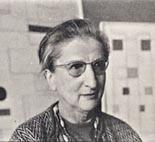
Marcelle Cahn is renowned not only for being one of the few female avant-garde artists of the first half of the twentieth century but also for her valuable contribution to one of the most important movements of the era. Having been born in Strasbourg she became involved in the legendary “Der Sturm” movement in Berlin. She moved to Paris in 1919 and befriended Vuillard, Maurice Denis and Christian Bérard. She attended the Académie de la Grande Chaumiere and then in 1925 came under the tuition of Fernand Léger and Amédée Ozenfant at their Académie Moderne where they who advocated a Purist hard-edge abstraction. Cahn exhibited these early works in the group show “Art d’Aujourd’hui”, she was the only woman in the show which included Picasso, Leger, Gris and Moholy-Nagy. In 1926 she exhibited with the radical “Société Anonyme” at the Brooklyn Museum. In her first works such as “Les Raquettes de Tennis” (1926), she allowed the influence of Ozenfant to show through but it was as early as 1927 that she defined her own style through works such as “Les Bobines”, and established herself as one of the leading exponents of geometrical abstraction. Léonce Rosenberg began to champion her work and in 1928 she joined the influential “Cercle et Carré” group that had been founded by Michel Seuphor, and in 1930 the subsequent more international “Abstraction-Création” group founded by August Herbin. These groups famously united the Abstract cause and with them Cahn exhibited alongside modern masters such as Piet Mondrian, Jean Arp, Albert Gleizes and Theo Van Doesburg, including at the Stedelijk Museum in Amsterdam in 1929.
Cahn’s career was interrupted during the Occupation of Paris but after the Liberation in 1944 her artistic career flourished again, producing compositions with a less rigid, more lyrical structure. She exhibited widely in the major salons including the Salon des Réalités Nouvelles which was set-up in the old premises of the “Abstraction-Création” group. As well as regular solo shows in Paris and internationally in London, Milan, Geneva, Zurich, Stockholm and Strasbourg. From 1972 until 1974, the Centre Nationale d’Art Contemporain celebrated Cahn’s remarkable career by organising a travelling exhibition tracing the evolution of her work from the Purist period of the twenties to her post-war abstraction.
When at the end of her life, she was too weak to paint, Cahn turned to collage as her medium, using an assortment of materials she continued to create and innovate. Marcelle Cahn seemed always to be looking for new experiences, she did not enclose herself to a singled defined idea, her universe always remained open.
The artist’s work is represented in numerous museum collections of Modern Art.